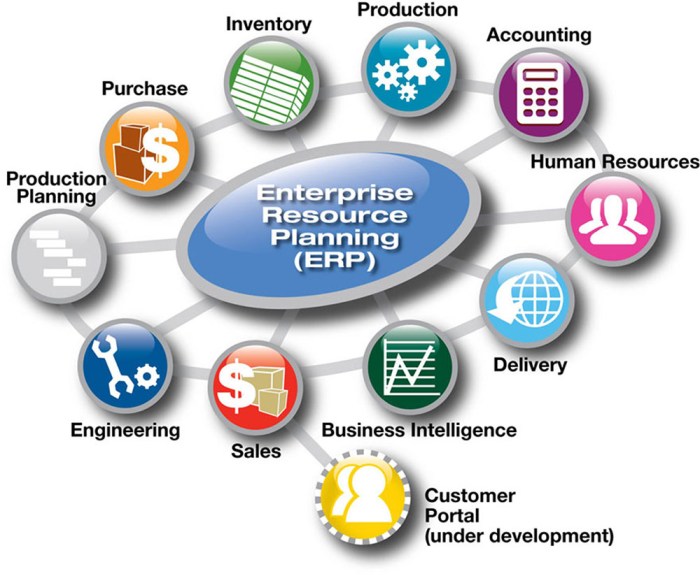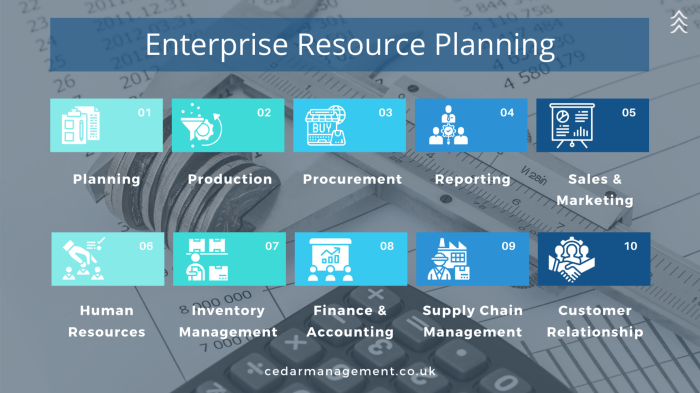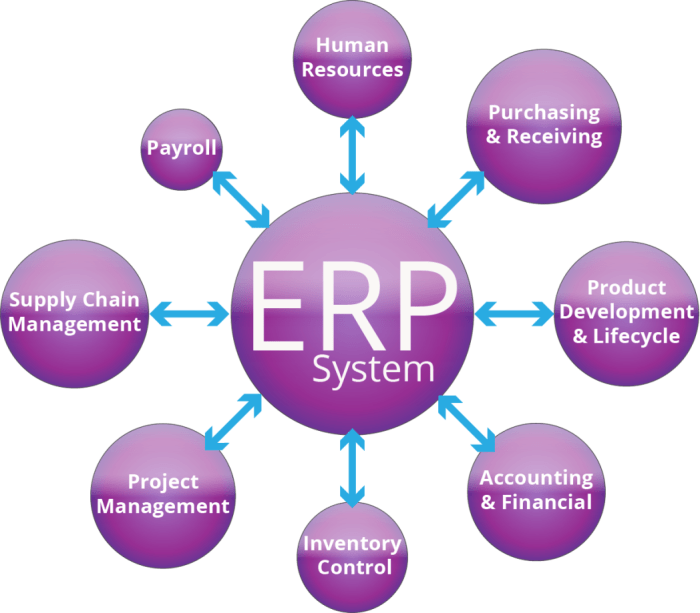TOP ERP SYSTEMS: Your Guide to Choosing the Right One
Originally posted 2024-08-29 03:37:00.
TOP ERP SYSTEMS are the backbone of modern businesses, streamlining operations and driving efficiency. But with so many options available, selecting the right ERP system can feel overwhelming. This guide will delve into the world of ERP systems, exploring their benefits, key features, and how to choose the ideal solution for your specific needs.
From understanding the core functionalities of ERP systems to navigating the complexities of implementation and integration, we’ll cover everything you need to know to make informed decisions. We’ll also examine the latest trends shaping the future of ERP, including the rise of cloud-based solutions and the integration of artificial intelligence.
Top ERP Systems
An Enterprise Resource Planning (ERP) system is a suite of integrated applications that an organization can use to manage its business processes. It’s a comprehensive system that helps businesses automate and streamline operations, manage resources, and improve efficiency. ERP systems are used by organizations of all sizes across a wide range of industries.
Top ERP Systems: Overview and Comparison
Choosing the right ERP system can be a challenging task. There are many different systems available, each with its own unique features and capabilities. This section provides an overview of some of the top ERP systems on the market, along with their strengths and weaknesses.
| ERP System | Overview | Target Audience | Industry Focus |
|---|---|---|---|
| SAP ERP | SAP ERP is a comprehensive ERP system that is suitable for large and complex organizations. It offers a wide range of modules, including finance, human resources, supply chain management, and customer relationship management. | Large enterprises, multinational corporations | Manufacturing, retail, automotive, pharmaceuticals, and other industries |
| Oracle ERP Cloud | Oracle ERP Cloud is a cloud-based ERP system that offers a wide range of features and capabilities. It is designed to be scalable and flexible, making it suitable for businesses of all sizes. | Businesses of all sizes, particularly those looking for a cloud-based solution | Manufacturing, retail, financial services, and other industries |
| Microsoft Dynamics 365 | Microsoft Dynamics 365 is a suite of cloud-based business applications that includes ERP functionality. It is designed to be user-friendly and affordable, making it a good option for small and medium-sized businesses. | Small and medium-sized businesses, particularly those looking for a cloud-based solution | Retail, manufacturing, services, and other industries |
| Infor CloudSuite | Infor CloudSuite is a cloud-based ERP system that offers a range of industry-specific solutions. It is designed to be flexible and scalable, making it suitable for businesses of all sizes. | Businesses of all sizes, particularly those in specific industries | Manufacturing, distribution, retail, and other industries |
The following table compares and contrasts the strengths and weaknesses of the top ERP systems:
| ERP System | Strengths | Weaknesses |
|---|---|---|
| SAP ERP |
|
|
| Oracle ERP Cloud |
|
|
| Microsoft Dynamics 365 |
|
|
| Infor CloudSuite |
|
|
Key Selection Criteria for ERP Systems

Choosing the right ERP system is a critical decision for any organization, as it can significantly impact efficiency, productivity, and profitability. A comprehensive evaluation process that considers various factors is crucial to ensure the chosen system aligns with the organization’s specific needs and goals.
Industry Alignment
The ERP system should be tailored to the specific requirements of the industry in which the organization operates. Different industries have unique processes, regulations, and reporting needs. For example, a manufacturing company would require an ERP system with features for production planning, inventory management, and quality control, while a healthcare organization would need features for patient management, billing, and compliance with HIPAA regulations.
While TOP ERP SYSTEMS focus on streamlining core business operations, managing IT infrastructure requires a dedicated solution. CENTRASTAGE RMM provides comprehensive remote monitoring and management capabilities, ensuring your IT environment runs smoothly and securely, complementing the efficiency gains achieved through a robust ERP system.
Business Size
The size of the business is a significant factor in ERP system selection. Smaller businesses may need a simpler and more affordable system, while larger enterprises require a more robust and scalable solution. The ERP system should be able to handle the organization’s current workload and have the capacity to grow as the business expands.
Budget
Budget is a major constraint in ERP system selection. The cost of an ERP system can vary significantly based on the features, functionality, and vendor. Organizations need to carefully assess their budget and select a system that provides the necessary features within their financial constraints.
Integration Requirements
Organizations need to consider the integration requirements of their existing systems with the ERP system. The ERP system should seamlessly integrate with other applications, such as CRM, accounting software, and e-commerce platforms. Integration ensures data consistency, reduces manual data entry, and improves overall efficiency.
Support Services
Reliable support services are essential for the successful implementation and ongoing operation of an ERP system. Organizations should consider the vendor’s reputation for providing prompt and efficient support, including training, documentation, and technical assistance.
TOP ERP SYSTEMS are essential for streamlining business processes and enhancing efficiency. While ERP systems focus on internal operations, RMM REMOTE MANAGEMENT solutions provide a vital layer of security and control over your IT infrastructure, allowing you to manage and monitor devices remotely.
This combination of robust ERP systems and comprehensive RMM solutions empowers businesses to achieve optimal performance and resilience.
Implementation and Integration Considerations
Implementing an ERP system is a complex and multifaceted process that requires careful planning, execution, and management. This section delves into the key stages, challenges, and best practices for successful ERP implementation.
While TOP ERP systems excel at managing core business processes, organizations often require additional solutions for specific needs. One such area is IT infrastructure management, where LOGICNOW RMM emerges as a powerful tool. This remote monitoring and management platform streamlines IT operations, allowing businesses to focus on strategic initiatives while ensuring optimal system performance.
By integrating LOGICNOW RMM into their technology stack, companies can achieve a comprehensive approach to managing their business, encompassing both ERP and IT infrastructure needs.
Data Migration and Integration
Data migration and integration are critical aspects of ERP implementation. It involves transferring data from existing systems to the new ERP system, ensuring data accuracy, consistency, and integrity.
TOP ERP systems are essential for businesses of all sizes, streamlining operations and providing valuable insights. However, managing IT infrastructure can be a separate challenge. That’s where CONNECT WISE RMM comes in, offering comprehensive remote monitoring and management capabilities.
By integrating with your ERP system, CONNECT WISE RMM can help you optimize IT performance and ensure seamless operations across your entire business.
- Data mapping and cleansing: This involves identifying and mapping data fields from existing systems to the new ERP system. It also involves cleaning and standardizing data to ensure accuracy and consistency.
- Data conversion and validation: Once data is mapped and cleansed, it needs to be converted into a format compatible with the new ERP system. Validation steps are essential to ensure data integrity and accuracy.
- Integration with existing systems: The ERP system needs to integrate seamlessly with existing systems, such as CRM, accounting, and inventory management systems. This ensures data flow and avoids redundancy.
Best Practices for Successful ERP Implementation
Successful ERP implementation requires careful planning, communication, and collaboration. The following best practices can significantly improve the chances of a smooth transition:
- User Training and Change Management:User training is essential for ensuring that employees understand and can effectively use the new ERP system. Effective change management strategies are crucial for addressing resistance to change and fostering user adoption.
- Phased Implementation:Implementing the ERP system in phases, starting with a pilot project, allows for gradual adoption and reduces the risk of overwhelming users. It also enables testing and refining the system before full deployment.
- Project Management and Communication:A dedicated project team with clear roles and responsibilities is essential for managing the implementation process. Effective communication channels should be established to keep stakeholders informed about progress, challenges, and solutions.
Future Trends in ERP Systems

The landscape of ERP systems is constantly evolving, driven by technological advancements and changing business needs. Organizations must stay informed about emerging trends to leverage their potential and remain competitive. This section explores key trends shaping the future of ERP systems, examining their impact and providing insights into adaptation strategies.
Cloud Computing
Cloud computing is transforming ERP systems by offering greater flexibility, scalability, and cost-effectiveness. Instead of investing in expensive hardware and software infrastructure, organizations can access ERP applications through the cloud, paying only for the resources they use. This model allows for rapid deployment, easier updates, and reduced IT overhead.
- Enhanced Accessibility:Cloud-based ERP systems can be accessed from anywhere with an internet connection, enabling remote work and collaboration.
- Scalability and Flexibility:Organizations can easily scale their ERP resources up or down based on changing business needs, eliminating the need for significant upfront investments.
- Cost-Effectiveness:Cloud-based ERP systems typically have lower upfront costs and ongoing maintenance expenses compared to on-premise solutions.
Organizations can adapt to cloud computing by evaluating their existing infrastructure, assessing cloud providers, and developing a cloud migration strategy.
TOP ERP SYSTEMS streamline your business operations, but they often rely on robust IT infrastructure. To ensure smooth functioning and data security, consider integrating a CLOUD BASED RMM solution. This proactive approach to IT management can help prevent issues before they impact your ERP system, keeping your business running efficiently and securely.
Artificial Intelligence
AI is revolutionizing ERP systems by automating tasks, improving decision-making, and enhancing customer experiences. AI-powered features can analyze vast amounts of data, identify patterns, and provide insights that can optimize operations, streamline processes, and enhance efficiency.
- Predictive Analytics:AI algorithms can analyze historical data to predict future trends, enabling organizations to anticipate demand, optimize inventory levels, and improve forecasting accuracy.
- Process Automation:AI can automate repetitive tasks, such as data entry and invoice processing, freeing up employees to focus on more strategic initiatives.
- Personalized Customer Experiences:AI can analyze customer data to provide personalized recommendations, targeted marketing campaigns, and improved customer service.
Organizations can adapt to AI by investing in AI-powered ERP solutions, training their workforce on AI technologies, and establishing clear data governance policies.
Blockchain
Blockchain technology is emerging as a potential game-changer for ERP systems, offering enhanced security, transparency, and efficiency. Blockchain can streamline supply chain management, track inventory, and improve financial transactions.
- Supply Chain Transparency:Blockchain can provide a secure and immutable record of transactions, enabling organizations to track goods and materials throughout the supply chain, reducing fraud and counterfeiting.
- Improved Traceability:Blockchain can enhance traceability by providing a complete history of products, from raw materials to finished goods, improving product recall processes and consumer confidence.
- Secure Data Sharing:Blockchain can facilitate secure data sharing between partners, eliminating the need for intermediaries and reducing the risk of data breaches.
Organizations can adapt to blockchain by exploring blockchain-based ERP solutions, partnering with blockchain experts, and developing a clear blockchain strategy.
Ultimate Conclusion: TOP ERP SYSTEMS

As you embark on your ERP journey, remember that choosing the right system is a strategic decision that can significantly impact your business’s success. By understanding the key selection criteria, evaluating different options, and planning for a smooth implementation, you can leverage the power of ERP systems to optimize your operations, enhance productivity, and drive growth.
FAQs
What are the most popular ERP systems?
Popular ERP systems include SAP, Oracle, Microsoft Dynamics 365, Salesforce, and NetSuite, each catering to different industry needs and business sizes.
How much does an ERP system cost?
ERP system costs vary significantly based on factors such as the chosen system, implementation complexity, customization requirements, and ongoing support needs.
What are the benefits of implementing an ERP system?
Benefits include improved efficiency, enhanced data visibility, streamlined processes, better decision-making, and increased profitability.